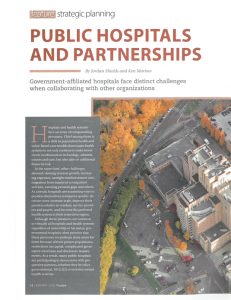Public Hospitals and Partnerships
 Hospitals and health systems face an array of compounding pressures. Chief among these is a shift to population health and value-based care models that require health systems to not only continue to make investments in information technology, administration and care, but also take on additional financial risk.
Hospitals and health systems face an array of compounding pressures. Chief among these is a shift to population health and value-based care models that require health systems to not only continue to make investments in information technology, administration and care, but also take on additional financial risk.
At the same time, other challenges abound: slowing revenue growth, increasing expenses, outright reimbursement cuts, migration from inpatient to outpatient services, yawning pension gaps and others. As a result, hospitals are examining ways to position themselves to improve quality, decrease costs, increase scale, improve their position relative to vendors, service providers and payers, and become the preferred health system in their respective region.
Although these pressures are common to virtually all hospitals and health systems, regardless of ownership or tax status, governmental hospitals often perceive that these pressures are perhaps more acute for them because of their patient populations, restrictions on capital, complicated governance structures and disclosure requirements. As a result, many public hospitals are participating in discussions with prospective partners, whether they be other governmental, 501(c)(3) or investor-owned health systems.
The range of governmental hospitals and partnership options is broad and includes hospitals that have some form of state, city, county, district, hospital authority or public trust involvement. This includes 501(c)(3) organizations that lease their facilities from governmental units, as well as quasi-governmental facilities with lingering public oversight.
The range of governmental hospitals and partnership options is broad and includes hospitals that have some form of state, city, county, district, hospital authority or public trust involvement. This includes 501(c)(3) organizations that lease their facilities from governmental units, as well as quasi-governmental facilities with lingering public oversight. Related to partnerships involving these organizations, this article will address certain predominant structures when relevant but use the terms partnership and combination to include to full array of structural alternatives including leases, asset purchase agreements, membership substitutions, joint operating agreements and joint ventures.
The resulting partnerships involving public hospitals include special governance, political, legal, business and regulatory considerations, which are relevant to boards because they affect how governmental hospitals can come together with partners. This article explores that unique attributes of public hospitals and the resulting restrictions and nonhealth care responsibilities they face when considering partnerships. Key considerations include ownership and governance, approvals, sunshine laws, political considerations, sovereign immunity and antitrust protections.